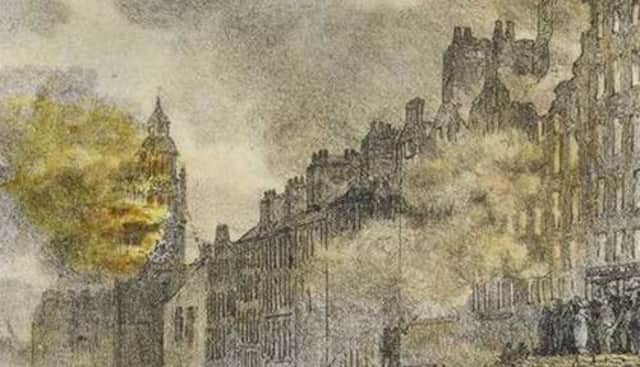Lost Edinburgh: The Great Fire of Edinburgh
This article contains affiliate links. We may earn a small commission on items purchased through this article, but that does not affect our editorial judgement.


Edinburgh has been no stranger to devastating blazes throughout its history. The overcrowded and tightly-packed tenements of the Old Town were at constant risk. There is, however, one year in the city’s history which is more intensely associated with such incidents than any other. The unprecedented number of large fires which took place during 1824 threatened to destroy Scotland’s capital and led many citizens to believe that God was out to punish them. The most terrible of these fires ignited on the evening of November 15.
Advertisement
Hide AdAdvertisement
Hide AdThe Great Fire officially began on the night of November 15, 1824 when clouds of smoke were seen to billow furiously from the second floor of a seven-storey printing house on Old Assembly Close. The fire, aided by the highly-flammable contents of the printing house, spread rapidly to nearby buildings, including the offices of the Edinburgh Courant - one of the city’s leading newspapers at the time. Within hours much of the south side of the High Street was ablaze and the conflagration was swiftly working its way towards Parliament Square and St Giles’ Cathedral. The city’s fire brigade, recognised as the world’s first official municipal fire service, had only recently been formed by 24-year-old pioneer James Braidwood. The firefighters had not yet received full training and struggled against the relentless blaze.
The following morning brought false hope as the chaos appeared to die down. The lull was broken as high winds met with the red hot embers from the smouldering tenement piles to resume the horror show. The flames gathered pace throughout the day and by noon the unthinkable had happened: the old Dutch steeple of the city’s historic Tron Kirk was engulfed in flames. The bulk of the building was spared further damage as the charred steeple was sent crashing into the street below. As the Scotsman reported at the time: “The upper part [of the steeple] being composed entirely of wood, the flames soon made their way through it, while the lead covering was seen pouring down its sides. In a short time it was completely enveloped in flames, presenting a most singular spectacle.” The destruction of the church’s steeple was too much for many citizens to take, many of whom were convinced that the fire was a vengeful act of God. Edinburgh chronicler Robert Chalmers captured the mood when he wrote “There was something sacred in its character as a church, which in everybody’s idea was supposed to exempt it from the attack of any such calamity.”
Worse was on its way at dusk as a third major fire broke out. An “immense pile” standing at 11 storeys high caught fire and began to zealously burn on the south side of Parliament Square. Soon afterwards, the fire was beginning to lick its way east and south towards South Bridge and the Cowgate. Much of the southern half of Edinburgh’s Old Town was now wreathed in flames. The destruction by far the worst the city had experienced for well over a century.
Four days passed before the fire was under control and extinguished. The cost of the Great Fire was extremely high. Thirteen people had died, including two firefighters, with many hundreds of others either badly injured or made homeless. Building damage amounted to over £200,000 – a colossal figure for the time. The fire was responsible for the loss of some of the oldest surviving architecture in the city and demanded the reconstruction of most of the south side of the High Street between the Tron Kirk in the east and St Giles’ in the west.
The spate of terrible blazes which afflicted Edinburgh in 1824 played a pivotal role in shaping the fire services as we know them around the globe today. These awful disasters led Braidwood to establish the first ever municipal fire brigade in the world. Braidwood, widely regarded as ‘the father of firefighting’, would eventually move on to set up a dedicated fire service in London. Sadly, it was there that he would meet his end in 1861 fighting a familiar foe at the great fire of Tooley Street. Braidwood’s legacy was suitably recognised by the city of Edinburgh in 2008 when a statue was erected. It stands on Parliament Square – the very place that had borne the brunt of the dreadful inferno all those years ago.